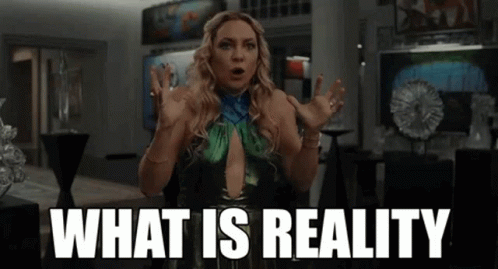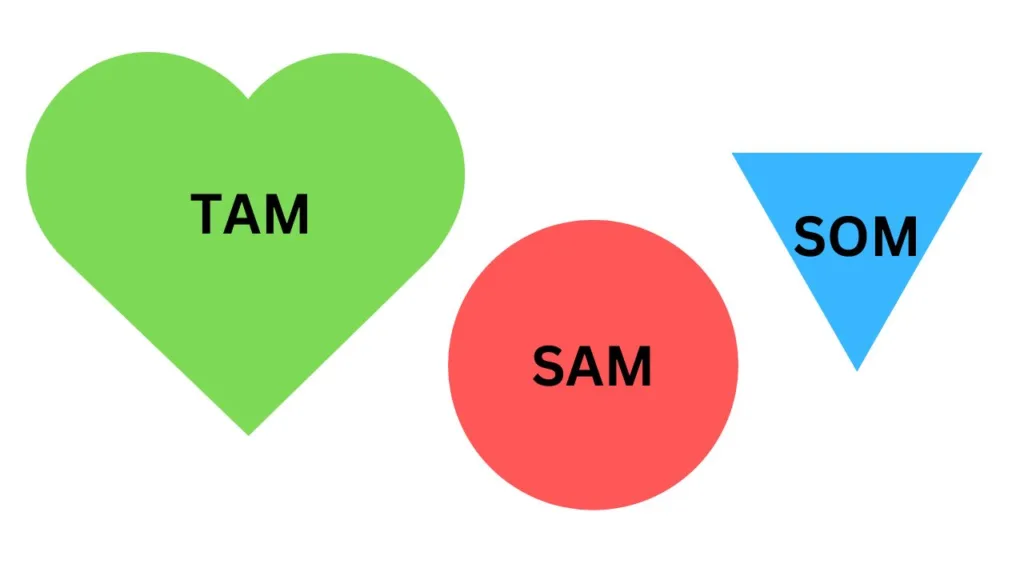Why can’t someone explain, in simple terms, what TAM, SAM, and SOM mean?

Well, as it turns out, there is no common standard for calculating these measures of market sizing.
But never fear! In this article we’ll take a close look at different ways to think about and calculate total addressable market (TAM), serviceable addressable market (SAM), and serviceable obtainable market (SOM).
Let’s go!
TAM, SAM, SOM Meaning
Even though I am a venture capital investor, I still struggle to explain the difference between TAM, SAM, and SOM.
It’s not surprising because the definitions that people throw around differ substantially depending on who you ask or what you read.
If you’ve been Googling around trying to make sense of this madness, you probably came across confounding definitions such as: “Portion of the market you can acquire based on your business model.” What the heck does that even mean?!
Or another favorite is: “The subset of the TAM that you can realistically and logistically capture based on your specific business model, targets/goals, and sales strategies.” As if my business model is to NOT try to capture as much of the market as is available. I’ll settle for just 5%, thanks. Is it me, or do these definitions sound like Martian?

In this section, I will attempt to define this alphabet soup in the simplest terms possible that the rest of us humans can understand.
Total Addressable Market (TAM) Meaning
Although total addressable market (TAM) is the most straightforward of the three definitions, I’ve seen it defined in a dozen different ways. Wikipedia itself has six (6!) different definitions of total addressable market in one article:
- “the revenue opportunity available for a product or service”
- “how much of the market any company can gain if there were no competitors”
- “the market size that could theoretically be served with a specific product or service”
- “a global total (even if a particular company could not reach some of it)”
- “a market that one specific company could serve (within realistic expansion scenarios)”
- “the total market demand for a product or service”
Do these definitions of TAM really mean the same thing? Why do these definitions have so many caveats? WHAT IS REALITY?!

In the simplest terms, total addressable market (TAM) refers to how much money you could make per year if you sold your product or service to everyone that could buy it.
TAM Example: Test Prep App
Let’s say that we’re looking to calculate the TAM for a SAT test prep app for high school students. Throughout the world, there are about 1.7 million high school students taking the SAT at least once per academic year. Let’s say that the SAT prep app charges its users $40 per year, then the TAM in terms of market size would be $68 million annually.
TAM Is Not the Total Industry Size
A lot of founders make the naive mistake of stating that the TAM for their product is the total revenue value for the entire industry. For example, a founder might claim that the TAM for the test prep app is $14.7 billion, which is the size of the entire test prep market. This includes in-person programs, books, software, tutors, etc. This is wrong and misleading.
Given that there are 1.7 million high school students taking the SAT, in order for the TAM for the SAT test prep app to be $14.7 billion, you’d have to charge each one $8,647 to use your app. Obviously, that’s ridiculous.
TAM Example: Ski Goggles
A better example might be the 125 million skiers and snowboarders worldwide as the total addressable market for a ski and snowboard goggle manufacturer. If the goggles sell for $100 on average and skiers buy new goggles every year, the TAM is $12.5 billion annually.

Is TAM a Dollar Amount or Number of Customers?
Another point of confusion is that people speak about TAM interchangeably as a dollar amount or audience population. Is it 125 million skiers or $12.5 billion for goggles that cost $100? Technically, it could be both, but it’s good to be specific. It’s also important to specify that your TAM is calculated in annual revenue, since people often adulterate this too.
When TAM Doesn’t Make Sense
Steve Blank and Bob Dorf give an example of a total addressable market or TAM in their seminal book, The Startup Owner’s Manual: “The TAM for makers of a new smartphone app might be the 1 billion total smartphone owners worldwide.”
The Startup Owner’s Manual example is nonsensical because a smartphone app solves a particular problem, and there is no app in the world that all smartphone owners use. In fact, the most ubiquitous smartphone apps are YouTube (with 74% penetration in the U.S.), GMail (62%), and Google Search (59%).
For example, let’s consider an app that helps users learn Spanish, the potential market isn’t all smartphone owners in the world; it’s just those smartphone owners that want to learn Spanish. But, you could easily get more granular.
Or maybe the TAM for a Spanish learning app is all Spanish learners worldwide. But does that also include school children in Spain and Latin American countries like Argentina?
Surely this wondrous Spanish language learning app is equally good at teaching school children, college children, and businessmen. (I’m being facetious.) This is nonsense.
TAM is completely arbitrary, and founders love to take advantage of this fact.
If you are doing a market sizing for a fund-raise, be realistic, detailed, and transparent about the assumptions that you’re making.
Don’t Lie About TAM
What often happens is that founders feel pressure to write down as large of a number as possible in their pitch deck. One founder stretches the definition, and another stretches it even more because they feel the pressure to out-do the first one.
Before you know it, founders are claiming that their TAM is the $12 trillion global healthcare industry or the $207 billion smartphone app industry.
Whoa! You mean to tell me that your digital health app can replace all the doctors, hospitals, medications, medical devices, etc. in the world? I’ll invest!
Whatever you do, please don’t fall into this trap. It might work on some investors, but most will see right through a bloated market size and will either think that you are lying or massively misinformed about your market. Neither is good.
Serviceable Addressable Market (SAM) Meaning
If TAM is arbitrary, the meaning of serviceable addressable market or serviceable available market (SAM) is even worse.
You might have been Googling around and read definitions of SAM such as:
- “the part of the total addressable market (TAM) that can actually be reached” – Wikipedia
- “that market opportunity that exists within a firm’s existing core competencies and/or past performance” – Wikipedia
- “the most immediate market you can add value to” – GrowthMentor
- “the market you can most realistically profit from given your current position” – GrowthMentor
- “the ‘slice’ of the TAM ‘pie’ that can be served by a company’s product and services” – Antler
- “portion of the market that you can acquire based on your business model” – Hubspot
Talk about arbitrary! “Can be reached” according to who? What do you mean by “existing core competencies and/or past performance?” Can’t my company add value to the entire market?
Surely my ski goggles could be enjoyed by all 125 million skiers and snowboarders. If I sell my ski goggles on Amazon and list them on Google Shopping where anyone in the world can buy them, couldn’t I potentially reach practically all 125 million skiers and snowboarders?
So what does SAM mean?
The gist, as far as I can tell, is basically that the serviceable addressable market (SAM) is some smaller portion of all potential customers that you can sell your product to given constrains such as what sales channels you have developed (e.g. your own website, yes, but not Amazon yet), regulations, etc.
SAM Example: Ski Goggles
For example, perhaps Amazon won’t allow you to sell your goggles on its platform, so you have to sell them only through your online store. And in every other country except the U.S., your goggle have to pass a strict safety screening before you can sell them there, and you haven’t done so in any other country. Also, perhaps the only package shipper that you can secure will only ship in the U.S.
Then your SAM might be 10.5 million skiers and snowboarders in the U.S. and the market size might be $1 billion annually if you’re selling goggles for $100 each.
SAM Example: Language Learning App
Similarly, you might say that a Spanish language learning app that is only available on iOS has a SAM that is only 28% of your TAM (globally and annually) since iOS only makes up 28% of the mobile market.
SAM Example: SAT Prep App
Going back to the example of the SAT Prep app. What would the SAM be for that one? If it’s available as a web-based app that anyone with an internet connection can access, wouldn’t the SAM also be 1.7 million SAT test takers? Perhaps not.
What if the SAT Prep App can only be purchased with a credit card, but only 60% of high school students taking the SATs have access to a credit card. The SAM would be 60% of 1.7 million SAT test takers or 1 million.
Perhaps the app is only available on iOS and only 30% of all SAT test takers worldwide have an iPhone. The SAM would further be reduced to 300,000 students that both had an iPhone and access to a credit card. At $40 per year, this results in a SAM of $12 million.
Serviceable Obtainable Market (SOM) Meaning
If you think that TAM and SAM are arbitrary, the serviceable obtainable market (SOM) will really knock your socks off.
Here are some fun definitions of SOM from the interwebs:
- “the portion of SAM that you can capture” – The Business Plan Shop
- “the portion of SAM that you can realistically win in the short term” – Yesware
- “the actual amount of the market that is being served by the company’s products and services” – Antler
- “the portion of the revenue within a specific product segment that a company is able to capture” – CFI
- “what a particular company is planning to achieve over the next five years in terms of sales” – Cayenne Consulting
Once again, these definitions floating around the internet lead to more questions than answers such as:
- How do I know what my company can capture and over what time?
- What is “short term”? A week, a year, five years?
- If my current sales are $100,000 per year, is that my SAM?
- Isn’t my company’s plan to serve the entire market in five years? So isn’t my SAM equal to my TAM?

So what does serviceable obtainable market really mean?
Serviceable obtainable market (SOM) is supposed to represent that part of the market that you could sell to today if you had unlimited marketing and sales capabilities. But the truth is that SOM doesn’t make sense in every scenario.
SOM Example: SAT Prep App
For example, in the SAT prep app example, the founders goal is to capture the entire 1.7 million market in the short term or at least in the next five years.
Can the company capture it? If the app is way, way better than anything else out there, one could make an argument that they can win a monopoly of the market. There are also no significant barriers to adoption other than maybe using a payment gateway that can take many kinds of payments.
Is it that unreasonable to assume that the company could reach practically all of the 1.7 million SAT test takers per year?
SOM Example: Language Learning App
A more fitting example might be that of the Spanish language learning app.
Perhaps the company is initially selling into K-12 school districts, and selling into companies is unreasonable over the next few years.
Then if we agreed that TAM was all Spanish learners and SAM was all schools and businesses with Spanish learners, SOM could be a subset of that–all K-12 schools with Spanish learners.
How to Calculate TAM, SAM, SOM
Granted there is a lot of subjectivity in defining TAM, SAM, and SOM, but sometimes, you just have to do it. How should you do calculate TAM, SAM, and SOM?
Here are some thoughts:
Calculating TAM from the Top Down
Savy investors take top-down market sizings with the biggest grain of salt because this method is very subjective and coarse.
For example, what is the market for the SAT prep app? According to Forbes, the test prep market is close to $30 billion. But how much of that is attributable to SAT prep specifically? Should your TAM include ACT, LSAT, MCAT, ACT prep and more? Another report pegs the global test preperation market at $489.8 million. That’s over 60X smaller–a humungous difference. Who’s right?
As you can see, you might as well throw a dart at a dartboard blindfolded. It’s a complete shot in the dark that can lead to disparate conclusions.
Which one would founders most likely put in their deck? I know, that’s a tough guess.
Calculating SAM and SOM from the Top Down
It get’s even more arbitrary when calculating SAM and SOM from the top down. What founders will often do is just throw out random percentages.
For example, founders will say that for SAM, they plan to capture 20% of the $30 billion test prep market and for SOM ($6 billion), they plan to capture 5% in the next couple of years ($300 million). Wonderful, but totally made up.
I don’t blame them, however, because detailed industry numbers are very hard to come by and there is no agreed-upon definition or methodology for calculating these numbers.
For example, I challange you to find a market sizing for SAT test takers that use iPhone and have access to a credit card.
Calculating Market Size from the Bottom Up
If you have to calculate a market size, I very strongly encourage you to do a bottom up market sizing calculation that takes into account your target audience and actual business model.
In fact, we already did one above for the SAT prep and ski goggle markets. For the SAT prep market, we said that the company is going to be targeting all 1.7 million SAT test takers. Their business model is to charge students $40 per year for access to their app. If we multiply those together, we get around $68 million annually.
If we the plan for the company in the next 5 years is to also expand into ACT, LSAT, MCAT, and AP test prep and students have to pay $40 for each subject per year (to keep it simple), the TAM would then be the total number of SAT, LSAT, MCAT, and AP test takers combined times $40.
The Best Example of TAM, SAM, and SOM
I really had to rack my brain to come up with an example of TAM, SAM, and SOM that would not be completely arbitrary and would actually make sense. But I think I have found one that should work.
Example: Medical Software for Electric Health Records
Let’s imagine that we’ve built a new, amazing electronic health records (EHR) software for hospitals that we sell for $50,000 per hospital annually (simple pricing to keep things easy). The software’s interface is only in English now and is HIPPA comliant (patient privacy regulation) for the U.S.
TAM Example: EHR Software
There are 6,129 hospitals in the U.S. and 165,000 globally. If there were no constraints due to language and regulation and your marketing budget and sales teams were infinitely large, you could potentially sell to all 165,000 hospitals, and your TAM in terms of revenue would be $8.25 billion USD.
SAM Example: EHR Software
Now let’s say that your EHR company has only received clearance in the U.S. and is in the process of getting regulatory clearance in Canada (702 hospitals) and the United Kingdom (1,921 hospitals), and they are both English-speaking countries (mostly).
In the next year or two you EHR company will be able to serve Canada, the U.K., and the U.S. That is a combined market of 8,752 hospitals or $437.6 million USD.
Now some folks would want you to pick a random percentage for reasonable penetration at this point. I think that’s rubbish because it’s completely arbitrary.
Also, what time period are we talking about? If we’re talking about 5 years, my plan is to localize my EHR into Spanish, French, German, and Japanese. So while I might not be able to get 100% penetration in these markets, I expect the number of markets to grow from three to more than a dozen in 5 years. Does that mean that my SAM should grow?
To be honest, there are no rules about this since nobody can agree on something even as basic as the definition of SAM. My recommendation is to do what you think is reasonable, explain your assumptions in detail, and be able to back up your calculations.
SOM Example: EHR Software
For now, let’s say that our EHR software company can only sell to U.S.-based hospitals due to language and regulatory constraints.
This means that my serviceable obtainable market is the 6,090 hospitals in the U.S. At $50,000 per hospital, per year that’s a SOM of $304.5 million USD.
Are we planning to achieve this level of revenue in 5 years? Absolutely! I’m an ambitious founder–the kind investors love.
Is it “reasonable” for my EHR company to reach 6,090 hospitals in the “short term” and achieve this level of revenue? Depends on what you mean by “short term” and “reasonable.” Given that we are also expecting to serve Canada, the U.K., and potentially other countries in the next few years, I’d say, “absolutely!”
Once again, some folks would want you to put a completely random market penetration percentage here. These folks seem to love the numbers 1 and 5, so you could say that your SOM is actually 5% of $306.5 million or $15.3 million USD.
I think this is complete BS. I recommend that you stick with the bigger number and let investors make up their own arbitrary penetration percentages.
Why TAM, SAM, SOM Are Irrelevant for Many Startups
Back when almost all companies were limited by physical constraints such as office buildings, factories and store fronts, TAM, SAM, and SOM made a lot more sense and still do for more traditionaly businesses. However, many of these constraints are not present or greatly reduced for software companies. It is essentially as easy for Google to serve a customer in the U.S. as in Signapore.
At the same time, the distinction for “serviceable” and “obtainable” become so vague and irrelevant for products like Tik Tok that how we decide to demarkate them becomes completely arbitrary and thus meaningless.
If these concepts cannot be consitently defined and are irrelevant, why do we still through them in a pitch deck? Why do we claim that your “serviceable” market is 5% of the total addressable market, while your “obtainable” market is 1%? The only reason I can think of is that it’s tradition that people are afraid to let go.
But let’s take a step back.
Why do we do market sizings in the first place? We do them to communicate to investors how big of an opportunity our business is addressing.
What do investors want to know? How big can this business reasonably get.
There is a better way. Create a market sizing that is based on your actual customer base, business model, and growth plan.
Bottom-up Market Sizing for Startups
Let’s take the example of the electronic health records (EHR) platform described above. The business model is that the company charges hostpitals a uniform, annual fee of $50,000 USD. (Once again, this is a simplification for illustrative purposes.) The current target customers are 6,090 U.S.-based hospitals right now, but the company is looking to expand.
The company is looking to raise a $5 million seed round to hire 15 sales people, 20 implementation engineers, and 10 client success people that will allow it to serve 2,000 hospitals in the next 1-2 years due to the super quick sales cycle and easy implementation.
Further, the company is aiming to raise a $50 million Series A round in 2 years, growing their staff to 100 sales people, 200 implementation engineers, and 100 client success speclialists. This would allow the company serve 5,000 hospitals within 5 years.
Finally the company is also planning to implement the necessary localization to serve customers in Spanish, German, French, and Japanese as well as to gain necessay approval in every country where they will operate. By year 3, the company plans to serve the U.S., U.K. and Canada. By year 5, the company plans to serve the U.S., U.K., Canada, Mexico, France, Spain, Germany, and Japan. Here is how many cospitals each country has:
| Country | Hospitals |
| United States | 6,090 |
| United Kingdom | 1,921 |
| Canada | 702 |
| Mexico | 4,909 |
| France | 2,989 |
| Spain | 771 |
| Germany | 3,006 |
| Japan | 8,238 |
A market sizing taking into account the company’s real business model, plans, and customers might look something like the following:
| Year 1 | Year 3 | Year 5 | |
| Geographic Markets | United States | United States, Canada, United Kingdom | United States, Canada, Mexico, United Kingdon, France, Spain, Germany, Japan |
| Number of Hospitals | 6,090 | 8,713 | 28,626 |
| Annual Revenue per Hospital | $50,000 | $50,000 | $50,000 |
| Total Potential Market | $304,500,000 | $435,650,000 | $1,431,300,000 |
Granted the above example of the EHR system does take into account geographic constraints. If we were to do a market sizing for a product like Tik Tok, which has an average revenue per user (ARPU) of $65.80, we might claim the following:
More than 99% of smartphone users use either Android or iOS and there are 6.84 billion smartphone users globally. ByteDance, the partent company of TikTok plans to use AI to localize the app to all major languages serving 90% of all smartphone users within 5 years.
The market size in 5 years would then be: (6.84 billion users) x (99% Android of iOS) x (90% language coverage) x $65.80 = $401,014,152,000.
TAM, SAM, SOM Takeaways
If you need to do a market sizing, make sure to do the following, so investors think you are well informed and not just making things up as you go:
- Do a bottom-up market sizing taking into account your actual business model and customers;
- If you must use TAM, SAM, and SOM, be clear about any assumptions that you’re making; and
- Be realistic and don’t make up numbers.
I hope this guide was helpful and demystified TAM, SAM, and SOM (if anyone can ever make sense of them). If I can make this guide better in any way or answer any questions, please connect with me on LinkedIn and let me know. Good luck!

Get on our radar for an investment.
Beta Boom invests in founders who don’t fit the traditional Silicon Valley mold.
More Resources: Top Pre-Seed Funds | Top Funds Investing in Women | Top Black-Led Funds | Top Latinx-Led Funds | Top Angel Investors | Best Startup Accelerators | Top FinTech Seed Funds | Top Health Tech Seed Funds | Angel Investor Guide | Complete Pre-Seed Guide

